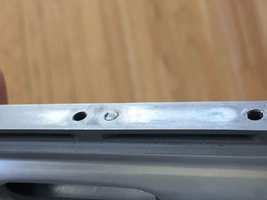Mesatchornug
NES Member
You may have to pick your battles here.It appears they’re 6-48 screws. DW used Weigand scope mounts initially and in the product description it says you need to drill and tap 3 6-48 holes.
I found the exact screws. Flat Head Type D Screw 5/16 in. 6-48.
Amazon product ASIN B07J9HL4MMView: https://www.amazon.com/Numrich-Flat-Head-Screw-Thread/dp/B07J9HL4MM
Now just need to find them in a higher grade. Could also use a torx head as someone else suggested.
McMaster only has a couple options in 6-48, lengths are 1/4 and 3/8. BoltDepot's finest pitch #6 seems to be 6-40. The Brownell's link above is probably going to be your best selection.
It looks (from your photo) like you can handle the extra 1/16" of length. That said, you have a fair amount of engagement in the screw you backed out, so the extra length isn't gaining you much.
I'd go with either purple or blue, making sure it's actually tight, and allowing the full 24 hours to set. Remember that that threadlocker is effectively a lubricant when you install it, so your torque requirement is slightly less. Maybe apply a dot with a paint pen on each fastener so you can visually confirm that nothing has moved over time.
[reason for edit - typo. had the estimated safe extra length off by enough that I felt it had to be fixed]
Last edited:


![Wink [wink] [wink]](/xen/styles/default/xenforo/smilies.vb/002.gif) your using that gun wants to go backwards and leave that scope were it is. the impulse shock must be huge.
your using that gun wants to go backwards and leave that scope were it is. the impulse shock must be huge.![Laugh [laugh] [laugh]](/xen/styles/default/xenforo/smilies.vb/012.gif)

![ROFL [rofl] [rofl]](/xen/styles/default/xenforo/smilies.vb/013.gif)

